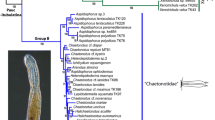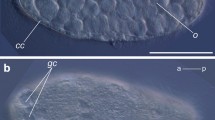Summary
A comparative anatomical and ultrastructural study of ventral pharyngeal organs (pharyngeal bulbs) was carried out in two species of the Dinophilidae: Dinophilus gyrociliatus and Trilobodrilus axi. Special attention was paid to the fine structure of the stomodeal epithelium, cuticle, glands, muscles, and myoepithelial junctions. The differences between the species are very slight. The pharyngeal organ of the Dinophilidae is characterized by the following features: solid muscle bulbus made up of muscle cells only, bulbus muscle cells with two myofilament systems crossing at an angle of about 90°, gap junctions between these muscle cells, bulbus projects into a pharyngeal sac and bears rostrally a specific epithelium and cuticle, no bulbus glands, no investing (= sagittal) muscles, specific cuticle ultrastructure, cilia of ascending oesophagus with asymmetric tips, specific structure and position of salivary gland openings. The phylogenetic importance of these structures is discussed. Some of these characters are clearly autapomorphic features of the Dinophilidae and no common derived structures to other families with a ventral pharyngeal organ are present. Therefore, it is most likely that the dinophilid pharyngeal organ evolved independently. These findings do not agree with the hypothesis of the unity of the archiannelid families (Polygordiidae, Protodrilidae, Saccocirridae, Nerillidae, Dinophilidae, and Diurodrilidae) established on the basis of an assumed structural similarity of their ventral pharyngeal organs.
Similar content being viewed by others
Abbreviations
- bb :
-
basal body
- bep :
-
bulbus epithelium
- bl :
-
basal lamina
- bm :
-
bulbus muscle
- c :
-
cilium
- cc :
-
coelenchyme cell
- cm :
-
circular muscle
- cr :
-
caudal rootlet
- cu :
-
cuticle
- dblm :
-
dorsal bulbus longitudinal muscle
- dlm :
-
dorsal longitudinal muscle
- dsn :
-
dorsal stomatogastric nerve
- dy :
-
dyad
- el :
-
electron-dense layer
- fl :
-
fibrous layer
- fi :
-
filaments
- g :
-
Golgi apparatus
- gl :
-
gland cell
- hv :
-
homogeneous vesicle
- l :
-
lipid droplet
- la :
-
external lamina
- lal :
-
lamellar layer
- ll :
-
lower lip
- lm :
-
longitudinal muscle
- ly :
-
lysosome
- m :
-
mitochondrion
- mo :
-
mouth opening
- mt :
-
microtubule
- mv :
-
microvillus
- mvp :
-
microvillar process
- n :
-
nucleus
- nu :
-
nucleolus
- oes :
-
oesophagus
- pcom :
-
preoral commissure
- phf :
-
pharyngeal fold
- phl :
-
pharyngeal lumen
- phs :
-
pharyngeal sac
- pms :
-
peripheral myofilament system
- r :
-
rootletlike structure
- rer :
-
rough endoplasmic reticulum
- rr :
-
rostral rootlet
- s :
-
sarcoplasmic reticulum
- sc :
-
salivary canal
- scom :
-
suboesophageal commissure
- sd :
-
septate desmosome
- ser :
-
smooth endoplasmic reticulum
- sg :
-
secretory granule
- sgl :
-
salivary gland
- sn :
-
stomatogastric nerve
- st :
-
stomach
- step :
-
stomodeal epithelium
- tep :
-
transitional epithelium
- tf :
-
tonofilaments
- va :
-
vacuole
- vlm :
-
ventral longitudinal muscle
- vsn :
-
ventral stomatogastric nerve
- z :
-
z-element
- za :
-
zonula adherens
References
Åkesson B (1977) Parasite-host relationships and phylogenetic systematics. The taxonomic position of dinophilids. In: Sterrer W, Ax P (eds) The meiofauna species in time and space. Mikrofauna Meeresboden 61:19–28
Ax P (1966) Die Bedeutung der interstitiellen Sandfauna für allgemeine Probleme der Systematik, Ökologie und Biologie. Veröff Inst Meeresforsch Bremerhaven 9 Sonderbd 2:15–65
Bantz M, Michel C (1971) Revêtement cuticulaire de la gaine de la trompe chez Glycera convoluta Keferstein (Annélide Polychète). Z Zellforsch 118:221–242
Boilly B (1967) Contribution a l'étude ultrastructurale de la cuticule épidermique et pharyngienne chez une annélide polychète (Syllis amica Quatrefages). J Microscopie 6:469–484
Boilly B (1970) Présence de collagène dans le proventricule des Syllidiens (Annélides Polychètes). Z Zellforsch 103:265–281
Brandenburg J (1970) Die Cuticula des Dinophilus (Archiannelida). Z Morphol Tiere 68:300–307
Brink PR, Kenseller RW, Dewey MM (1979) The effect of lanthanum on the nexus of the anterior byssus retractor muscle of Mytilus edulis L. Am J Anat 154:11–26
Bubel A (1983) A transmission and scanning electron microscope study of the cuticle and epidermis of Pomatoceros lamarckii (Polychaeta:Serpulidae). Trans Zool Soc London 36:217–268
Bubko OV (1973) On systematic position of Oweniidae and Archiannelida (Annelida). Zool Zh 52:1286–1296 (In Russian)
Burke JM (1974) An ultrastructural analysis of the cuticle, epidermis and esophageal epithelium of Eisenia foetida (Oligochaeta). J Morphol 142:301–320
Comolli A, Ferraguti M (1975) An unusual obliquely striated muscle pattern: The myoendothelial cell of the blood vessels of Tubificidae (Annelida: Oligochaeta). Monit Zool Ital (NS) 9:25–36
Damas D (1973) Ultrastructure de l'épithélium tégumentaire de Glossiphonia complanata (L.) (Hirudinée): Cellules épitheliales et organes sensoriels de Bayer. Z Zellforsch 143:355–365
Desser SS, Weller J (1977) Ultrastructural observations on the body wall of the leech, Batracobdella picta. Tissue Cell 9:35–42
Dorsett DA, Hyde R (1970) The epidermal glands of Nereis. Z Zellforsch 110:219–230
Fauchald K (1974) Polychaete phylogeny: A problem in protostome evolution. Syst Zool 23:493–506
Fransen ME (1980) Ultrastructure of coelomic organization in annelids. I. Archiannelids and other small polychaetes. Zoomorphologie 95:235–249
Gardiner SL (1978) Fine structure of the ciliated epidermis on the tentacles of Owenia fusiformis (Polychaeta, Oweniidae). Zoomorphologie 91:37–48
Giere OW, Riser NW (1981) Questidae-polychaetes with oligochaetoid morphology and development. Zool Scr 10:95–103
Goodrich E (1912) Nerilla an archiannelid. Quart J Microsc Sci 57:397–425
Hama KMD (1960) The fine structure of the blood vessels of the earthworm (Eisenia foetida). J Biophys Biochem Cytol 7:717–724
Heider K (1922) Über Archianneliden. S-B preuss Akad Wiss:39–44
Hermans CO (1969) The systematic position of the Archiannelida. Syst Zool 18:85–102
Ivanov DL, Tzetlin AB (1981) Origin and evolution of the cuticular pharyngeal armature in trochophore animals having the ventral pharynx. Zool Zh 60:1445–1454 (In Russian)
Jägersten G (1947) On the structure of the pharynx of the Archiannelida with special reference to there-occurring muscle cells of aberrant type. Zool Bidr Uppsala 25:551–570
Jennings JB, Gelder SR (1969) Feeding and digestion in Dinophilus gyrociliatus (Annelida, Archiannelida). J Zool London 158:441–451
Jones ER (1956) The operation of the pharyngeal bulb in the archiannelid Dinophilus. Q J Fla Acad Sci 19:121–122
Jouin C (1978a) Anatomical and ultrastructural study of the pharyngeal bulb in Protodrilus (Polychaeta, Archiannelida). I. Muscles and myo-epithelial junctions. Tissue Cell 10:269–287
Jouin C (1978b) Anatomical and ultrastructural study of the pharyngeal bulb in Protodrilus (Polychaeta, Archiannelida). II. The stomodeal epithelium and its cuticle. Tissue Cell 10:289–301
Kristensen RM, Niilonen T (1982) Structural studies on Diurodrilus Remane (Diurodrilidae fam. n.) with description of Diurodrilus westheidei sp. n. from the Arctic interstitial meiobenthos, W. Greenland. Zool Scr 11:1–12
Lanzavecchia G (1977) Morphological modulations in helical muscles (Aschelminthes and Annelida). Intern Rev Cytol 51:133–186
Larsen WJ (1977) Structural diversity of gap junctions. A review. Tissue Cell 9:373–394
Mamkaev V, Selivanova RV (1979) Morphological study on Dinophilus vorticoides O. Schmidt with some ultrastructure data. Akad Nauk SSSR Zool Inst Trudy 84:73–83 (In Russian)
Martin GG (1978) Ciliary gliding in invertebrates. Zoomorphology 91:249–261
Michel C (1969) Ultrastructure et histochimie de la cuticle pharyngienne chez Eulalia viridis Müller (Annélide Polychète Errante, Phyllodocidae). Etude de ses rapports avec l'épithélium sousjacent dans le cycle digestif. Z Zellforsch 98:54–73
Michel C (1972) Etude ultrastructurale et histochimique des papilles de la gaine de la trompe de Notomastus latericus Sars (Annélide Polychète sédentaire). Z Zellforsch 128:482–503
Michel C de Villez EJ (1980) Cuticle and mucous glands in the oesophagus of an annelid (Nereis virens). Tissue Cell 12:673–683
Mileikovsky SA (1977) On the systematic interrelationships within the Polychaeta and Annelida — An attempt to create an integrated system based on their larval morphology. Essays on polychaetous annelids in memory of Dr. Olga Hartman. Allan Hancock Fdn, pp 503–524
Nelson JA (1907) The morphology of Dinophilus conklini n.sp. Proc Acad nat Sci Philadelphia 59:82–143
Ohm G (1963) Über den Bau des Pharynx einiger Archianneliden. Zool Anz 171:179–203
Orrhage L (1973) Two fundamental requirements for phylogenetic scientific works as a background for an analysis of Dales' (1962) and Webb's (1969) theories. Z Zool Syst Evolutionsforsch 11:161–173
Orrhage L (1974) Über die Anatomie, Histologie und Verwandtschaft der Apistobranchidae (Polychaeta, Sedentaria) nebst Bemerkungen über die systematische Stellung der Archianneliden. Z Morphol Tiere 79:1–45
Reger JF (1967) A fine structure study on the organization and innervation of pharyngeal glands and associated epithelium in the annelid Enchytraeus albidus. J Ultrastruct Res 20:451–461
Richards KS (1974) The ultrastructure of the cuticle of some British lumbricids (Annelida). J Zool 172:303–316
Richards KS (1978) Epidermis and cuticle. In: Mill PJ (ed) Physiology of annelids. Academic Press, New York, pp 33–61
Rieger RM (1980) A new group of interstitial worms, Lobatocerebridae nov. fam. (Annelida) and its significance for metazoan phylogeny. Zoomorphologie 95:41–84
Rieger RM (1981) Fine structure of the body wall, the nervous tissue, and the digestive system of the Lobatocerebridae Rieger (Annelida) and remarks to the organization of the gliointerstitial system in Annelida. J Morphol 167:139–165
Rieger RM, Rieger GE (1975) Fine structure of the pharyngeal bulb in Trilobodrilus and its phylogenetic significance within Archiannelida. Tissue Cell 7:267–279
Rieger RM, Rieger GE (1976) Fine structure of the archiannelid cuticle and remarks on the evolution of the cuticle within the Spiralia. Acta Zool (Stockholm) 57:53–68
Rieger RM, Ruppert E, Rieger GE, Schoepfer-Sterrer C (1974) On the fine structure of gastrotrichs with description of Chordodasys antennatus sp. n. Zool Scr 3:219–237
Storch V, Welsch U (1972) The ultrastructure of epidermal mucous cells in marine invertebrates (Nemertini, Polychaeta, Prosobranchia, Opisthobranchia). Mar Biol 13:167–175
Sveshnikov VA (1958) On the morphology of larvae of some Eunicemorpha (Polychaeta). Dokl Akad Nauk SSSR 121:565–568 (In Russian)
Tyler S (1979) Distinctive features of cilia in metazoans and their significance for systematics. Tissue Cell 11:385–400
Tyler S, Rieger RM (1977) Ultrastructural evidence for the systematic position of the Nemertodermatida (Turbellaria). In: Karling TG, Meinander M (eds) The Alex Luther centennial symposium on Turbellaria. Acta Zool Fenn 154:193–207
Tzetlin AB (1980) Ophryotrocha schubravyi sp.n. and the problem of evolution of the mouth parts in the Eunicemorpha (Polychaeta). Zool Zh 59:666–676 (In Russian)
Ude J (1977) Licht- und elektronenoptische Untersuchung des Septaldrüsensystems von Pachydrilus lineatus (Annelida, Oligochaeta). Zool Jahrb Physiol 81:42–82
Welsch U (1968) Über den Feinbau der Chorda dorsalis von Branchiostoma lanceolatum. Z Zellforsch 87:69–81
Westheide W (1978) Ultrastructure of the genital organs in interstitial polychaetes. I. Structure, development, and function of the copulatory stylets in Microphthalmus cf. listensis. Zoomorphology 91:101–118
Westheide W (1979) Ultrastruktur der Genitalorgane interstieller Polychaeten. II. Männliche Kopulationsorgane mit intrazellulären Stilettstäben in einer Microphthalmus-Art. Zool Scr 8:111–118
Westheide W (1982a) Ikosipodus carolensis gen. et sp.n., an interstitial neotenic polychaete from North Carolina, USA, and its phylogenetic relationships within Dorvilleidae. Zool Scr 11:117–126
Westheide W (1982b) Ultrastructure of the genital organs in interstitial polychaetes. III. Penes and ejaculatory ducts in Hesionides arenaria (Hesionidae). Helgoländer Meeresunters 35:479–488
Westheide W (1985) The systematic position of the Dinophilidae and the archiannelid problem. In: Morris CS, George D, Gibson R, Platt HM (eds) The origin and relationships of lower invertebrates. Oxford University Press, Oxford (in press)
Westheide W, Rieger RM (1978) Cuticle ultrastructure of hesionid polychaetes (Annelida). Zoomorphologie 91:1–18
Westheide W, Riser NW (1983) Morphology and phylogenetic relationships of the neotenic interstitial polychaete Apodotrocha progenerans n. gen., n. sp. (Annelida). Zoomorphology 103:67–87
Westheide W, Schmidt P (1974) Trilobodrilus axi (Polychaeta). Nahrungsaufnahme und Fortpflanzung. Begleitveröffentlichung zum Film E 1955. Encycl Cinematogr 1–12
Wilfert M (1975) Nachweis eines Pharynxbulbus bei Polychaeten aus der Familie Flabelligeridae. Helgoländer Wiss Meeresunters 27:313–323
Wolf G (1980) Morphologische Untersuchungen an den Kieferapparaten einiger rezenter und fossiler Eunicoidea (Polychaeta). Senckenb Marit 12:1–182
Author information
Authors and Affiliations
Rights and permissions
About this article
Cite this article
Purschke, G. Anatomy and ultrastructure of ventral pharyngeal organs and their phylogenetic importance in Polychaeta (Annelida). Zoomorphology 105, 223–239 (1985). https://doi.org/10.1007/BF00311966
Received:
Issue Date:
DOI: https://doi.org/10.1007/BF00311966




